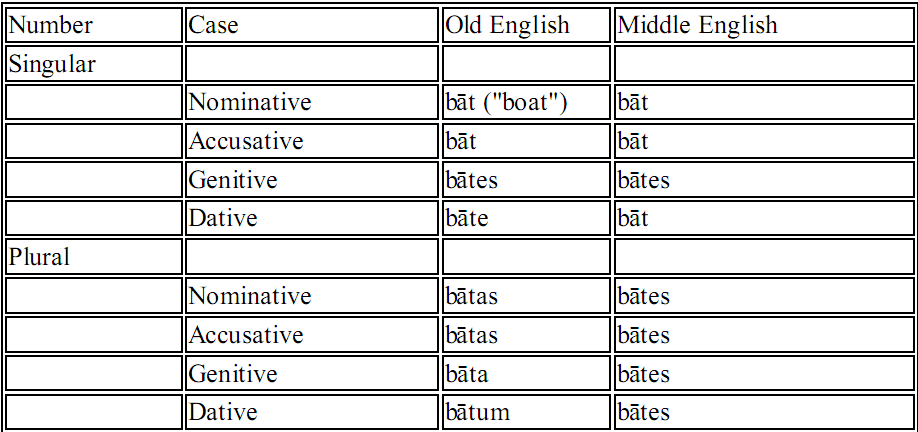
- •1. Linguistic features of Germanic languages: vowels.
- •Indo-European short o and a appear as short a:
- •3. Linguistic features of Germanic languages: consonants.
- •4. Me phonetics: vowel (reduction, shortening/lengthening,
- •5. The Earliest Period of Germanic History
- •6. Me phonetics. Developm. Of Old English diphthongs inМe
- •7.Basic grammatical features of Germanic languages. Runes
- •8. The Great vowel shift. R
- •Vowel Shift was a major change in the pronunciation of Germanic languages. It represented a change in the long vowels.
- •9. Chronological division in the history of English. Short survey of periods.
- •10. New English Phonetics: loss of unstressed –e, the change of –er into –ar, a into ǽ. Rise of new phonemes.
- •11. Old English. Historical background.
- •3 Gramm. Categories:
- •12. Ne phonetics: the 17th century changes.
- •13. Old and Modern Germanic languages.
- •14. Middle and New English noun: morphological classification, grammatical categories.
- •15. Old English Dialects and Written Records.
- •16. Origing of modern irregular noun forms
- •17. Oe phonetics: vowels ( breaking, diphtongization, palatal mutation, shortening/lengthening).
- •18. Me & ne adjective and pronoun
- •19. Oe phonetics: consonants (voicing of fricatives, rhotasism, palatilizatin, metathesis, loss of consonants in certain position).
- •20. Middle and New English adverb, Numeral, the Article.
- •21. Oe Verb. Grammatical categories and morphologiacal classification.
- •22 Morphological classification of verbs in me and ne
3 Gramm. Categories:
- case OE was fully inflected with five grammatical cases (nominative, accusative, genitive, dative, and instrumental).
–gender feminine, masculine, neutral.
-number sing, pl
The language was further altered by the transition away from the runic alphabet to the Latin alphabet. Old English words were spelt as they were pronounced. phoneticall spelling was extremely variable.
the Scandinavian words introduced during the Viking invasions of the 9th and 10th centuries. - administrative aspects. The four main dialectal forms of Old English were Mercian, Northumbrian, Kentish, and West Saxon. Each of those dialects was associated with an independent kingdom on the island.
12. Ne phonetics: the 17th century changes.
Vocalisation of [r]
It occurred in the 16th – 17th c. Sound [r] became vocalised (changed to [ə] (schwa)) when stood after vowels at the end of the word.
Consequences:
new diphthongs appeared: [εə], [iə], [uə];
the vowels before [r] were lengthened (e.g. arm [a:m], for [fo:], etc.);
triphthongs appeared: [aiə], [auə] (e.g. shower [‘∫auə], shire [‘∫aiə])
13. Old and Modern Germanic languages.

Modern Germanic languages
English – Great Britain, Ireland, the USA, Canada, Australia, New Zealand, the South African Republic, and many other former British colonies;
German – Germany, Austria, Luxemburg, part of Switzerland;
Netherlandish – Netherlands and Belgium;
Afrikaans –the South African Republic;
Danish – in Denmark; Swedish – in Sweden and Finland;
Norwegian – in Norway; Icelandic – in Iceland;
Frisian – in some regions of the Netherlands and Germany;
Faroese – in the Faroe Islands;
Yiddish – in different countries.
14. Middle and New English noun: morphological classification, grammatical categories.
-es for genitive singular and all plurals:

The OE Gender disappeared together with other distinctive features of the noun declensions
Reduction of case-system from OE to NE:
OE: nominative, acusative, dative, genitive.
ME: common, dative, genitive.
NE:common, genitive.
-weak declension endings (-n) survived into early ME then merged with strong declension (children, brethren, oxen); some ME words had plurals with -n: eyen, earen, shoen, handen
-some unmarked plurals: some OE strong neuter nouns had no ending in the nominative and accusative plural, continued in ME (year, thing, winter, word); unmarked plurals for animal names (derived from OE unmarked neuter plurals, e.g. der, shep, hors, swin); measure words without -s in the plural (mile, pound, fathom, pair, score)
-es group: a-stems (m and n), u-stems (m), i-stems (m), root-stems, loan words
-en group: n-stems (f, m and n), u-stems (f), ō-stems (f), i –stems (f)
Root-stems levelled their plural in accordance with the general rule:
OE bōc – bēc - ME bok – bokes
(16) The structure of the Oenoun consists of 3 elements: the root+stem-building suffix+the ending;
Root-stem nouns never had any stem-building suffix, that’s why the ending was added on immediately to the root of the noun and caused mutation of the root-vowel.
